Long Division
This is what is called an "algorithmic process". Below is the process written out in full. You will often see other versions. These are generally just a shortened version of the process below.
Let’s see how it is done with 425 ÷ 25
There are two definitions we must make first.
- the number to be divided into is known as the dividend (425 from above)
- The number which divides the other number is known as the divisor (25 from above)
 |
4 ÷ 25 = 0 remainder 4 | The first number of the dividend is divided by the divisor. |
 |
The whole number result is placed at the top. Any remainders are ignored at this point. | |
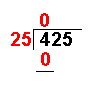 |
25 × 0 = 0 | The answer from the first operation is multiplied by the divisor. The result is placed under the number divided into |
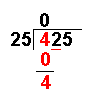 |
4 – 0 = 4 | Now we take away the bottom number from the top number. |
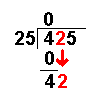 |
Bring down the next number of the dividend. | |
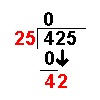 |
42 ÷ 25 = 1 remainder 17 | Divide this number by the divisor. |
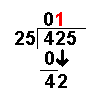 |
The whole number result is placed at the top. Any remainders are ignored at this point. | |
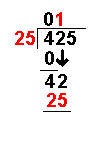 |
25 × 1 = 25 | The answer from the above operation is multiplied by the divisor. The result is placed under the last number divided into. |
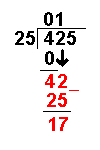 |
42 – 25 = 17 | Now we take away the bottom number from the top number. |
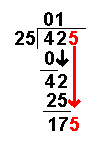 |
Bring down the next number of the dividend. | |
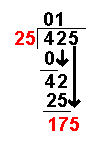 |
175 ÷ 25 = 7 remainder 0 | Divide this number by the divisor. |
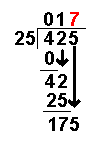 |
The whole number result is placed at the top. Any remainders are ignored at this point. | |
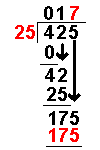 |
25 × 7 = 175 | The answer from the above operation is multiplied by the divisor. The result is placed under the number divided into. |
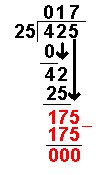 |
175 – 175 = 0 | Now we take away the bottom number from the top number. |
| There are no more numbers to bring down. The answer must be 17 |
Document Actions

 Like us on Facebook
Like us on Facebook